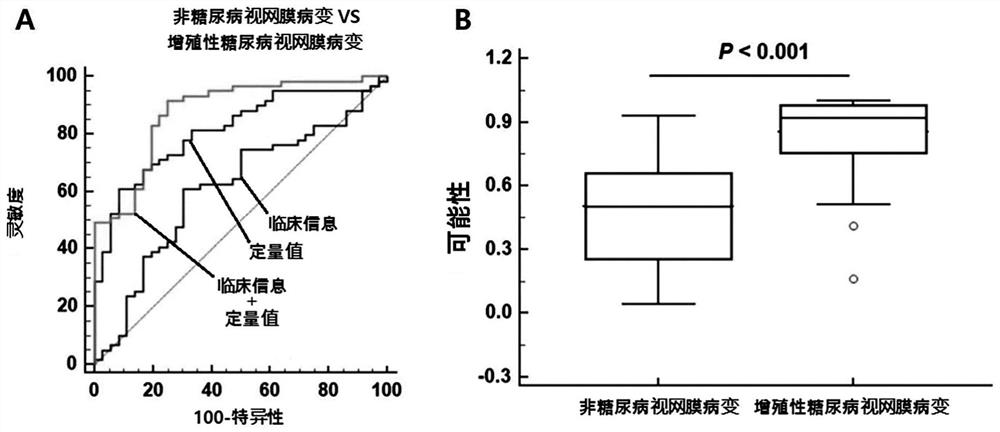Composite marker for diagnosis of diabetic retinopathy and use thereof
A diabetic retina and biomarker technology, applied in biological testing, disease diagnosis, biomaterial analysis, etc., can solve the problems of unknown etiology, limited biomarkers of retinopathy, etc., and achieve the effect of high diagnostic ability
- Summary
- Abstract
- Description
- Claims
- Application Information
AI Technical Summary
Problems solved by technology
Method used
Image
Examples
Embodiment 1
[0106] Example 1: Selecting patients with diabetic retinopathy and collecting plasma
[0107] Plasma samples from patients with diabetic retinopathy were collected with approval from the Clinical Trial Review Board of Seoul National University Hospital, Bundang. For the quantitative detection of biomarkers, a total of 155 plasma samples were analyzed by plasma proteomics, and the clinical characteristics of the normal group (Non DMR) and the diabetic retinopathy (DMR) disease group that were analyzed are shown in Table 1 below .
[0108] Table 1
[0109] Sample clinical information
[0110]
[0111]
Embodiment 2
[0112] Example 2: Selection of Peptides and Quantitative Analysis of Peptides Using Multiple Reaction Monitoring Mass Spectrometry
[0113] 2-1: Selection of peptides and design of synthetic peptides
[0114] In the present invention, as biomarkers for the diagnosis of diabetic retinopathy, the following 13 were screened: IGFBP2 (insulin-like growth factor binding protein 2), ADAMTSL2 (ADAMTS-like protein 2), CFH (complement factor H), Cp (ceruloplasmin), DDI2 (protein DDI1 homolog 2), FCN2 (fibrin glue 2), LGALS3BP (galectin 3-binding protein), MBL2 (mannose-binding protein C), PNLIP (pancreatic triacyl glycerol lipase), SELE (E-selectin), SIGLEC14 (sialic acid binding immunoglobulin-like lectin 14), THBS1 (thrombospondin-1) and ZG16B (zymogen granulin 16 homolog B).
[0115] For multiple reaction monitoring analysis of the above biomarkers, representative peptides (Q1) with charge-to-mass ratio (m / z) specific to the proteins of the 13 biomarkers were selected and produc...
Embodiment 3
[0129] Example 3: Confirmation of Improved Diagnostic Capability Based on Combining Composite Biomarker Panel Results with Clinical Information
[0130] In the present invention, when combining the results of the 13 composite biomarker groups with clinical information, in order to confirm the improvement effect of diagnostic ability, the conversion information of biomarker expression level and the conversion degree of clinical information are input using the logistic regression model, and the classification is estimated from this is the probability of diabetic retinopathy.
[0131] table 3
[0132] Confirmation of Diabetic Retinopathy Diagnostic Performance Based on Combined Number of Composite Biomarkers
[0133]
[0134] 1. Clinical information, 2. LGALS3BP, 3. MBL2, 4. IGFBP2, 5. PNLIP, 6. ZG16B, 7. DDI2, 8. FCN2, 9. THBS1, 10. SIGLEC14, 11. CP, 12. ADAMTSL2, 13 .SELC, 14.CFH
[0135] Table 4
[0136] Confirmation of diagnostic capability based on combining composi...
PUM
 Login to View More
Login to View More Abstract
Description
Claims
Application Information
 Login to View More
Login to View More - R&D
- Intellectual Property
- Life Sciences
- Materials
- Tech Scout
- Unparalleled Data Quality
- Higher Quality Content
- 60% Fewer Hallucinations
Browse by: Latest US Patents, China's latest patents, Technical Efficacy Thesaurus, Application Domain, Technology Topic, Popular Technical Reports.
© 2025 PatSnap. All rights reserved.Legal|Privacy policy|Modern Slavery Act Transparency Statement|Sitemap|About US| Contact US: help@patsnap.com



